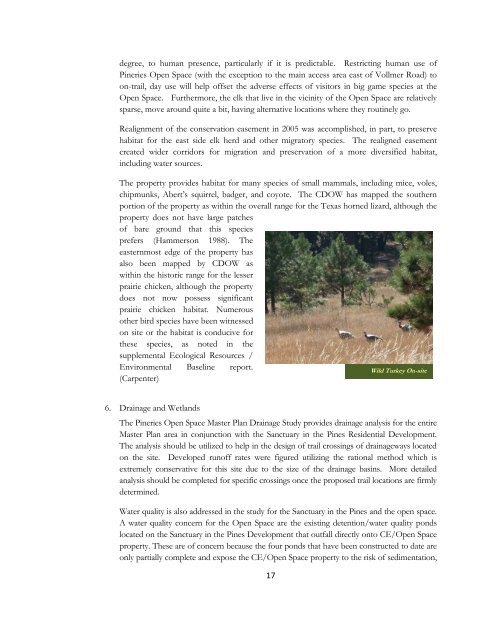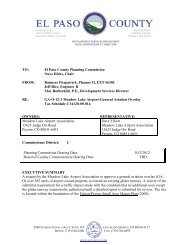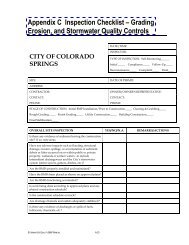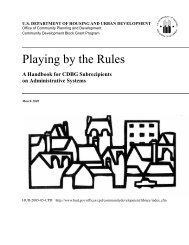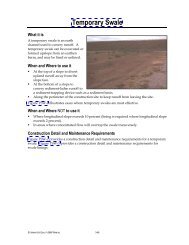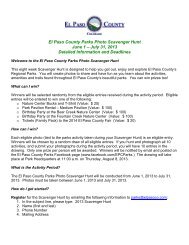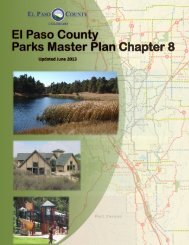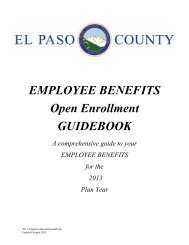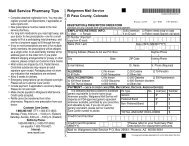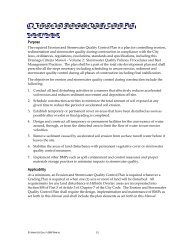Pineries Open Space Master Plan
Pineries Open Space Master Plan
Pineries Open Space Master Plan
Create successful ePaper yourself
Turn your PDF publications into a flip-book with our unique Google optimized e-Paper software.
degree, to human presence, particularly if it is predictable. Restricting human use of<br />
<strong>Pineries</strong> <strong>Open</strong> <strong>Space</strong> (with the exception to the main access area east of Vollmer Road) to<br />
on-trail, day use will help offset the adverse effects of visitors in big game species at the<br />
<strong>Open</strong> <strong>Space</strong>. Furthermore, the elk that live in the vicinity of the <strong>Open</strong> <strong>Space</strong> are relatively<br />
sparse, move around quite a bit, having alternative locations where they routinely go.<br />
Realignment of the conservation easement in 2005 was accomplished, in part, to preserve<br />
habitat for the east side elk herd and other migratory species. The realigned easement<br />
created wider corridors for migration and preservation of a more diversified habitat,<br />
including water sources.<br />
The property provides habitat for many species of small mammals, including mice, voles,<br />
chipmunks, Abert’s squirrel, badger, and coyote. The CDOW has mapped the southern<br />
portion of the property as within the overall range for the Texas horned lizard, although the<br />
property does not have large patches<br />
of bare ground that this species<br />
prefers (Hammerson 1988). The<br />
easternmost edge of the property has<br />
also been mapped by CDOW as<br />
within the historic range for the lesser<br />
prairie chicken, although the property<br />
does not now possess significant<br />
prairie chicken habitat. Numerous<br />
other bird species have been witnessed<br />
on site or the habitat is conducive for<br />
these species, as noted in the<br />
supplemental Ecological Resources /<br />
Environmental Baseline report.<br />
Wild Turkey On-site<br />
(Carpenter)<br />
6. Drainage and Wetlands<br />
The <strong>Pineries</strong> <strong>Open</strong> <strong>Space</strong> <strong>Master</strong> <strong>Plan</strong> Drainage Study provides drainage analysis for the entire<br />
<strong>Master</strong> <strong>Plan</strong> area in conjunction with the Sanctuary in the Pines Residential Development.<br />
The analysis should be utilized to help in the design of trail crossings of drainageways located<br />
on the site. Developed runoff rates were figured utilizing the rational method which is<br />
extremely conservative for this site due to the size of the drainage basins. More detailed<br />
analysis should be completed for specific crossings once the proposed trail locations are firmly<br />
determined.<br />
Water quality is also addressed in the study for the Sanctuary in the Pines and the open space.<br />
A water quality concern for the <strong>Open</strong> <strong>Space</strong> are the existing detention/water quality ponds<br />
located on the Sanctuary in the Pines Development that outfall directly onto CE/<strong>Open</strong> <strong>Space</strong><br />
property. These are of concern because the four ponds that have been constructed to date are<br />
only partially complete and expose the CE/<strong>Open</strong> <strong>Space</strong> property to the risk of sedimentation,<br />
17


